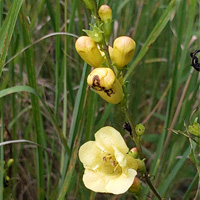Smooth Yellow False Foxglove
Scientific name: Aureolaria flava

Photo credit: Mike Burrell
Status
Threatened
“Threatened” means the species lives in the wild in Ontario, is not endangered, but is likely to become endangered if steps are not taken to address factors threatening it.
Date added to the Species at Risk in Ontario List
January 26, 2022
Read the assessment report (PDF)
What it looks like
Smooth Yellow False Foxglove is a tall, herbaceous perennial with showy yellow flowers, that can reach a height of 2.5 m. The stems and leaves of this plant are smooth and it will send up multiple flowering stalks each year.
Where it lives
Smooth Yellow False Foxglove is found in dry, open to semi-open upland oak forests typically with White Oak present, on well-drained soils. The full range of Smooth Yellow False Foxglove beyond southern Ontario covers most of the Eastern United States extending from Wisconsin to Maine in the north and from Texas to Florida in the south.
Where it’s been found in Ontario
There are seven remaining subpopulations in southern Ontario which are potentially viable located in:
- Essex County
- Norfolk
- Walpole Island First Nation
- Hamilton
- Waterloo
- Halton
An eighth subpopulation may persist in Middlesex County. About 18 subpopulations are believed to be extirpated including ones from Brant County, Haldimand County, the Region of Niagara and the City of Toronto.
What threatens it
Smooth Yellow False Foxglove faces threats due to its association with open to semi-open oak ecosystems. Oak ecosystems across eastern North America are in decline for a variety of reasons. Fire suppression and invasive species are threats because they result in shading and competition from other species.
Moderate to severe damage to plants may result from browsing by White-tailed Deer. The expansion of formal trail networks that cause an increase in human foot traffic could also pose a risk to this plant species.
Action we are taking
Threatened species and their habitat is protected under Ontario’s Endangered Species Act, 2007.
What you can do
Report a sighting
Submit your observations of species at risk to the Natural Heritage Information Centre (NHIC), which is Ontario’s conservation data centre. Join the “(NHIC) Rare Species of Ontario” project in iNaturalist to make submitting your observations quick and easy.
Volunteer
Volunteer with species at risk programs, such as community science surveys, through your local nature club, a provincial park or other conservation organizations.
Be a good steward
- Individuals, communities and organizations across the province who undertake stewardship or research activities that benefit species at risk and their habitats may be eligible to receive funding through the Species at Risk Stewardship Program (SARSP). The SARSP was created to encourage people to get involved in protecting and recovering species at risk in Ontario through stewardship actions.
- Invasive species seriously threaten many of Ontario’s species at risk. To learn what you can do to help reduce the threat of invasive species, visit:
Report illegal activity
Report any illegal activity related to species at risk to
Quick facts
- All Yellow False Foxglove species secure some of their water and nutrients by tapping into the roots of other plants, particularly oak species (Quercus spp).
- Mature plants flower in mid-to-late summer, with some plants still flowering in late fall.
- Fern-leaved Yellow False Foxglove and Smooth Yellow False Foxglove are the sole larval food source for False-foxglove Sun Moth, which is listed on the Species at Risk in Ontario List as an Endangered insect species.